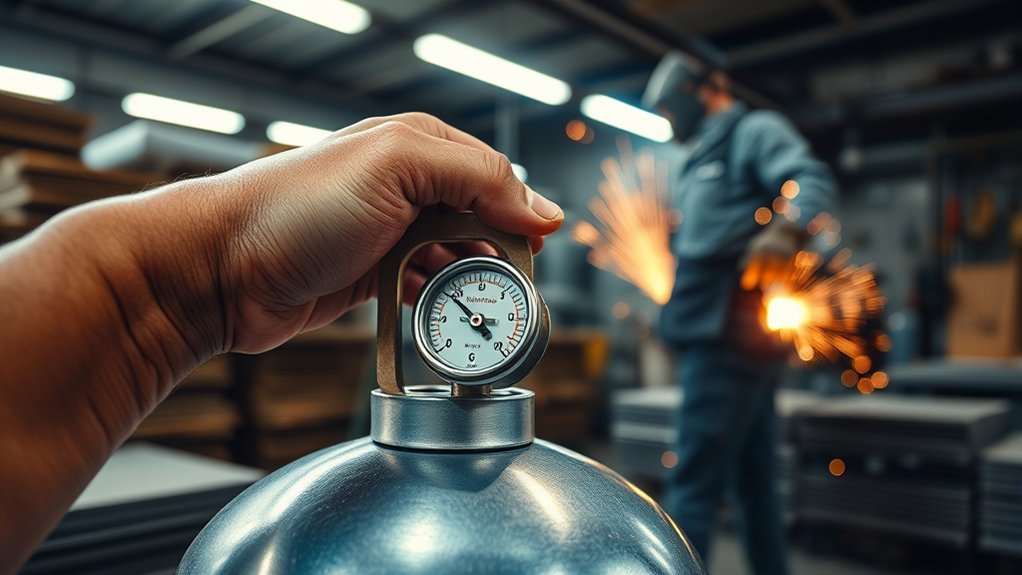Welding oxygen prices depend on cylinder size and material. For instance, small aluminum cylinders start at around $84.80, while larger steel cylinders can go up to $189.80. Refilling costs also vary; expect around $60 for a 40 cuft tank and $70 for an 80 cuft tank. Larger tanks often offer more economical refills, making them a smart choice in the long run. Discover more about costs and effective tank choices as you continue this exploration.
Understanding Welding Oxygen Cylinder Sizes
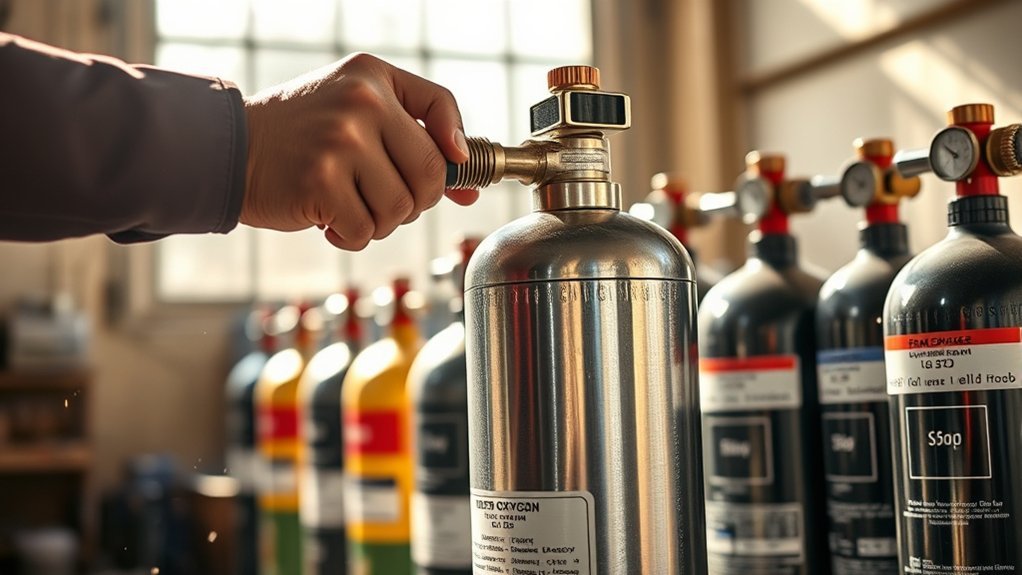
Welding oxygen cylinders come in various sizes, each designed to meet different needs and applications. Common cylinder dimensions include 20 cuft, 40 cuft, 80 cuft, and 125 cuft.
Choosing the right size offers distinct advantages; for instance, the 80 cuft cylinder strikes a balance between portability and gas capacity, making it ideal for many welding tasks. Larger cylinders like the 125 cuft provide more gas, resulting in more cost-effective refills compared to smaller ones, such as the 40 cuft tank.
You can calculate usage duration by dividing the cylinder volume by the gas flow rate, with flow rates typically ranging from 10 CFH to 40 CFH.
Always verify your cylinder has a valid DOT stamp and current hydrostatic test for safety.
Pricing Breakdown for Welding Oxygen Cylinders
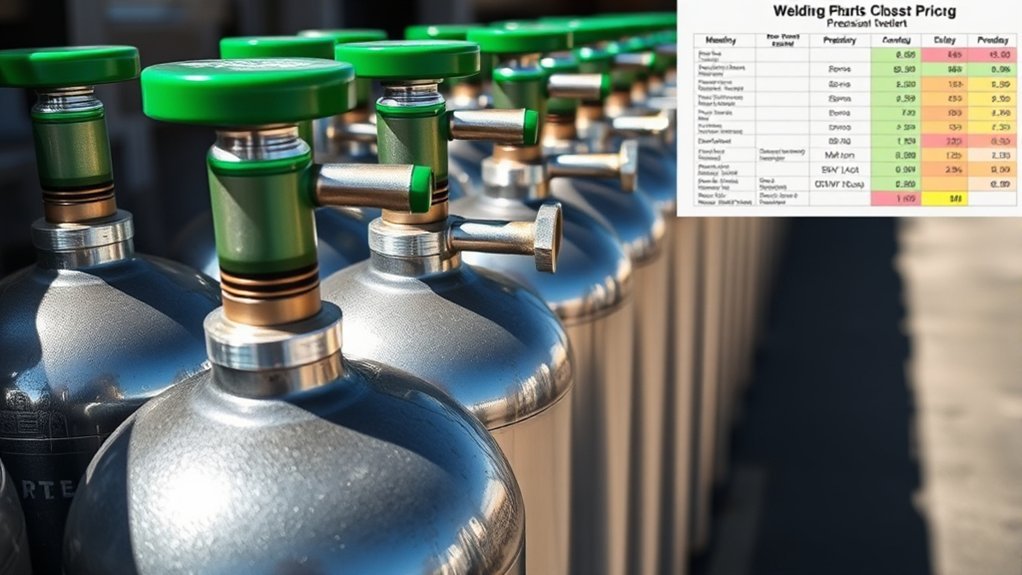
When selecting a welding oxygen cylinder, understanding the pricing is just as important as knowing the sizes available. Currently, a new 15 cuft aluminum oxygen cylinder costs $84.80, while a 20 cuft steel cylinder is priced at $73.80.
For larger projects, the 125 cuft steel cylinder costs $187.60. Prices for aluminum cylinders range from $84.80 to $309.80, whereas steel cylinders range from $73.80 to $189.80.
Additionally, specific cylinders may be available at discounted sale prices, providing cost-effective options for your welding needs.
Initial Costs vs. Refill Expenses
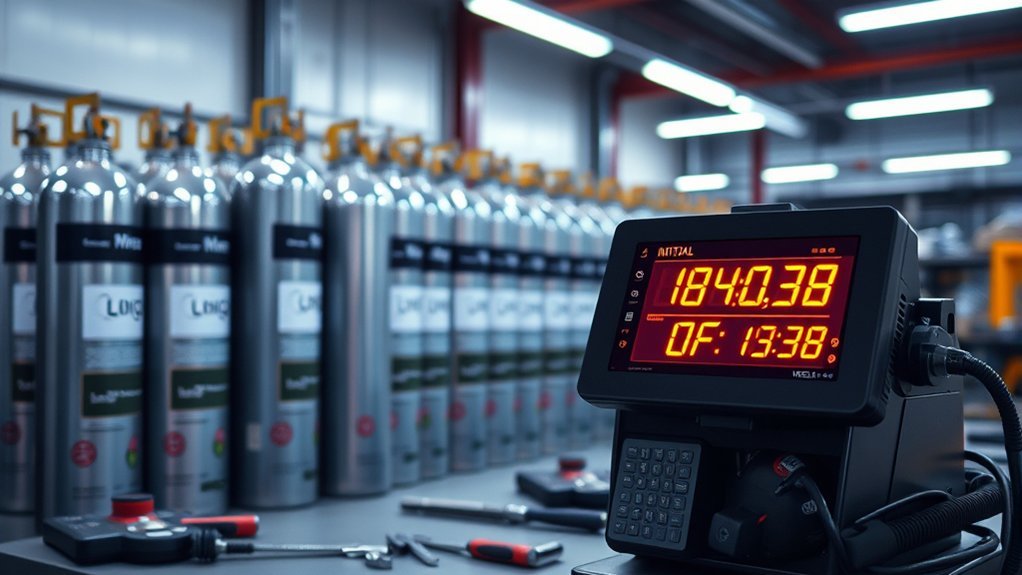
Understanding the balance between initial costs and refill expenses is essential for managing your welding oxygen budget effectively.
Your initial investment for a 20 cuft steel cylinder is about $73.80, while a 125 cuft cylinder costs around $187.60.
However, ongoing expenses emerge with refills, which can vary considerably based on tank size. For example, refilling a 40 cuft tank typically costs about $60, compared to approximately $70 for an 80 cuft tank.
If you opt for an 80 cuft tank and refill every two months, your total first-year cost could reach around $660.
Larger tanks like the 125 cuft often provide more economical refills, making them a preferable choice when factoring in long-term expenses.
Factors Influencing Welding Gas Prices
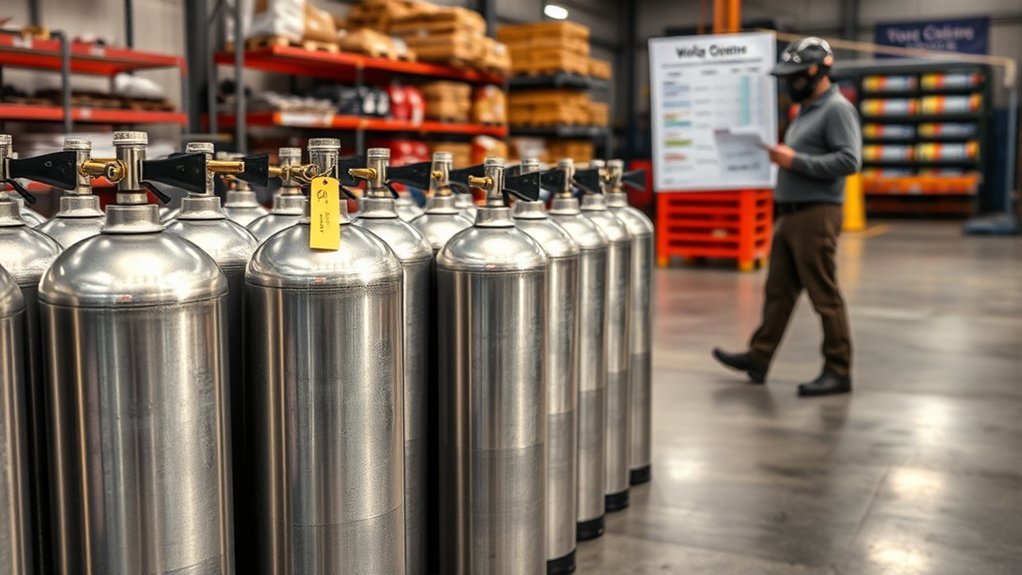
Several factors influence the prices of welding gas, impacting your overall expenses. One key element is market demand; when demand rises, prices typically follow suit.
Additionally, fluctuations in the supply chain can lead to variations in costs. For instance, the price difference between aluminum and steel cylinders reflects material availability and production costs.
Larger tanks, while initially more expensive, often offer more cost-effective refills due to similar labor expenses during the refilling process. You’ll also find refill costs vary considerably based on tank size, which can affect your budgeting.
Keeping these aspects in mind helps you make informed choices about your welding gas purchases and manage your expenses effectively.
Where to Purchase or Refill Welding Oxygen
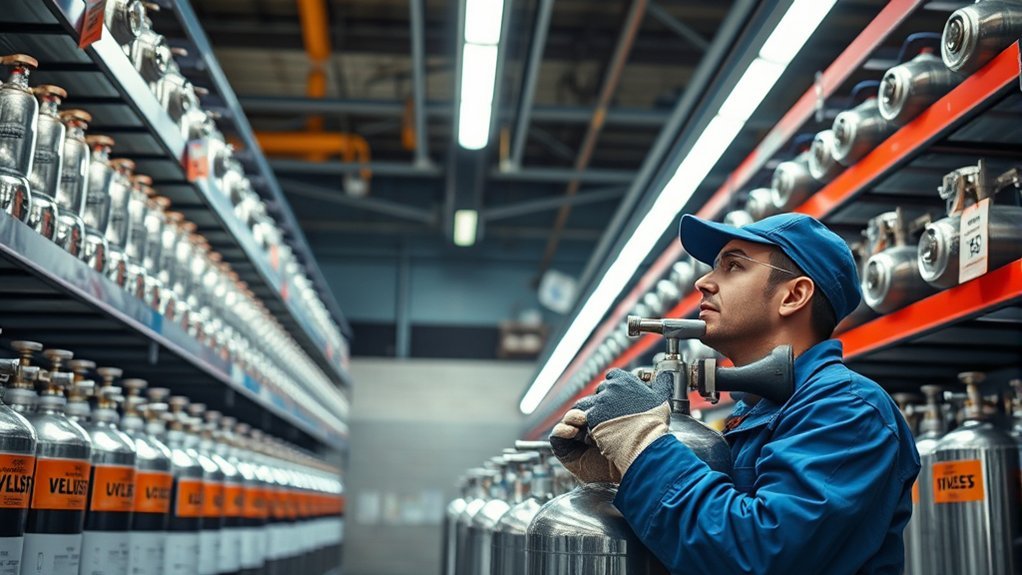
You can purchase or refill welding oxygen from local gas suppliers or online retailers, ensuring you compare prices for the best deal.
Many suppliers also offer cylinder exchange programs, allowing you to easily swap out your empty cylinder for a filled one.
Always check for a valid DOT stamp and current hydrostatic test stamp to meet safety standards.
Local Gas Suppliers
Finding a reliable local gas supplier for welding oxygen is essential for any welding project.
Local suppliers like AirGas and Northern Tool offer a variety of options for purchasing and refilling oxygen cylinders. Prices for aluminum cylinders range from $84.80 to $309.80, while steel cylinders cost between $73.80 and $189.80.
When it comes to refilling, expect to pay around $60 for a 40 CF tank and $70 for an 80 CF tank—larger tanks often provide better long-term value.
Many local suppliers also offer convenient exchange services, allowing you to swap empty cylinders for full ones.
Always verify that your tanks have a valid DOT stamp and current hydrostatic test stamp for safety and compliance.
Online Retail Options
Local gas suppliers like AirGas and Northern Tool provide several options for purchasing and refilling welding oxygen, but online retail options are also worth considering.
Through online shopping, you can find various cylinder types to suit your needs. For instance, aluminum cylinders range from $84.80 for a 15 cuft to $309.80 for a larger M122 cuft option. Steel oxygen cylinders start at $73.80 for a 20 cuft cylinder and go up to $189.80 for a 125 cuft model.
While many retailers allow you to refill or exchange customer-owned cylinders, this usually applies only to those purchased or leased from them.
Always compare prices and services among online and local suppliers to secure the best deals on welding oxygen.
Cylinder Exchange Programs
When considering welding oxygen supplies, cylinder exchange programs offer a convenient solution for obtaining full cylinders while disposing of empty ones.
These programs allow you to trade in your empty, customer-owned, rented, or leased cylinders for full replacements, saving you time and effort. The benefits of this exchange include reduced downtime and the guarantee that your cylinder is maintained properly.
To maximize your experience, remember these cylinder maintenance tips: check for leaks, verify proper storage, and schedule regular inspections.
Local gas suppliers typically provide detailed information about their exchange and refill options, including size and pricing details—like the approximate $60 refill for a 40 cuft tank.
Always clarify any additional fees that may apply during the process.
Duration of Welding Oxygen in Cylinders
Understanding how long your welding oxygen will last involves considering both the flow rate and the tank size.
By calculating the duration using the tank’s volume and your specific flow rate, you can estimate usage effectively.
Keep in mind that flow rates typically range from 10 to 40 CFH, greatly impacting how long your oxygen supply will last.
Flow Rate Impact
Since the flow rate greatly impacts how long welding oxygen lasts in a cylinder, it’s crucial to take into account your usage needs. The duration can be calculated by dividing the tank’s volume in cubic feet by your flow rate, typically ranging from 10 CFH to 40 CFH.
For instance, an 80 CF tank at a flow rate of 10 CFH lasts about 8 hours. Higher flow rates deplete the tank more quickly, affecting your welding efficiency.
Additionally, monitoring the pressure gauge helps you gauge remaining oxygen; a full tank reads around 2015 psi, while a 50% spent tank shows about 1000 psi.
Understanding flow rates guarantees you optimize your welding operations and manage costs effectively.
Tank Size Considerations
Selecting the right tank size for welding oxygen is crucial for meeting your specific usage demands. The duration of welding oxygen in a cylinder largely depends on its volume and your gas flow rate.
For instance, an 80 cu/ft tank at a flow rate of 10 CFH lasts about 8 hours. Flow rates can vary from 10 to 40 CFH, which directly influences how long a tank will last.
A fully charged 80 cu/ft cylinder typically has a tank pressure around 2015 psi, while a 50% spent tank will show about 1000 psi.
Regular cylinder maintenance, including up-to-date hydrostatic testing, is essential to guarantee safety and effectiveness in your welding operations.
Choose wisely to avoid interruptions.
Usage Duration Estimates
When estimating how long welding oxygen will last in a cylinder, it’s essential to take into account the tank’s volume and your specific gas flow rate.
For typical welding techniques, consider these examples:
- An 80 CF tank at 10 CFH lasts about 8 hours.
- At a flow rate of 20 CFH, it lasts approximately 4 hours.
- A full tank pressure reads around 2015 psi, while a 50% spent tank shows about 1000 psi.
Larger tanks decrease refill frequency, making them more cost-effective for ongoing gas applications.
Safety and Handling of Welding Oxygen
Handling welding oxygen safely is essential to prevent accidents and guarantee a secure working environment. Always adhere to established safety protocols and handling procedures.
Store oxygen in high-pressure cylinders that have a valid DOT stamp and a current hydrostatic test stamp. Keep these cylinders away from flammable materials and sources of ignition to minimize fire hazards.
Store oxygen cylinders safely, ensuring they have a valid DOT stamp and are kept away from flammable materials to prevent fire hazards.
Always wear appropriate personal protective equipment (PPE), such as gloves and goggles, to safeguard against injuries.
Refer to the Safety Data Sheets (SDS) provided for welding oxygen, as they outline essential safe handling guidelines and emergency procedures.
Frequently Asked Questions
Can I Use Welding Oxygen for Medical Purposes?
You shouldn’t use welding oxygen for medical purposes. Medical oxygen must meet strict purity standards, while welding oxygen can contain impurities. Prioritize welding safety and guarantee you use the appropriate medical-grade oxygen for health needs.
What Are the Risks of Storing Welding Oxygen at Home?
Storing welding oxygen at home can be a ticking time bomb if mishandled. Guarantee proper storage safety; risks include fire hazards, explosion potential, and contamination. Implement risk management strategies to mitigate dangers effectively.
How Often Should I Replace My Oxygen Cylinder?
You should replace your oxygen cylinder every 5 to 10 years, depending on its cylinder lifespan and usage frequency. Regularly inspect it for damage, and always follow safety guidelines to guarantee peak performance and safety.
Are There Any Environmental Concerns With Welding Oxygen?
Yes, there are environmental concerns with welding oxygen. Welding emissions contribute to air pollution and can harm ecosystems. To minimize environmental impact, consider using cleaner technologies and proper ventilation while welding to reduce harmful effects.
Can I Transport Welding Oxygen in My Vehicle?
Yes, you can transport welding oxygen in your vehicle, but you must follow transport regulations. Make certain you secure the cylinder, avoid extreme temperatures, and take necessary safety precautions to prevent accidents and leaks during transit.
Conclusion
To summarize, understanding the costs associated with welding oxygen can save you money and guarantee efficient use in your projects. While initial cylinder prices can be steep, refills generally offer a more economical option. Curiously, many welders believe that cheaper oxygen may compromise quality; however, reputable suppliers guarantee consistent performance regardless of price. By knowing where to purchase and how to handle your equipment safely, you can maximize both your budget and your welding efficiency.

